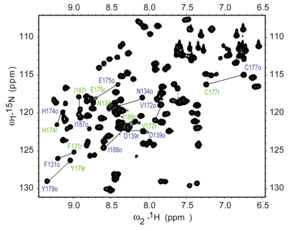Contributed by +Jan Jensen
source CC
The H-N HSQC spectrum of protein amide groups is one of the most frequently recorded experiments in protein NMR. $^{15}$N labeling is comparatively inexpensive and the spectrum can be acquired in a relatively short period of time. Protein structure validation using just this spectrum would therefore be ideal and, in principle, possible since the N in particular is believed to report on many aspects of protein structure.
Accurate (within ca 0.3 ppm) predictions of backbone amide H chemical shifts (CS) are possible and can be used to improve protein structures. However, accurate (within ca 1 ppm) predictions of N CS have so far remained elusive.
Accurate N chemical shift predictions are possible
The paper by Teale et al. shows that accurate predictions of N CSs are possible. The benchmark set contains five molecules (NH$_3$, N$_2$, HCN, N$_2$O, and PN) for which N-chemical shieldings have been measured in the gas phase. One of the molecules contain 2 N atoms so one can compute five CSs (using NH$_3$ as a reference). Using CCSD(T)/CBS//CCSD(T)/cc-pVTZ these five chemical shifts can be reproduced to within 2.2 ppm (and to within 1.4 ppm if the PN molecule is excluded). However, such accuracy is only possible if vibrational effects (computed using the method due to Ruud et al. at the B3LYP/aug-cc-pCVTZ level of theory) are included because they contribute between -4.8 and 1.5 ppm to the CSs.
More benchmark data needed
Thus, conventional predictions of amide N CSs will contain an offset, the difference between the vibrational contributions to the chemical shielding of the amide and reference N. It would be very interesting to know what this offset is for an amide group and how much it depends on the local environment such as dihedral angles, side-chains, and hydrogen bonding.
Of course, similar data is also needed for the electronic component at the CCSD(T)/CBS level for benchmarking faster method. Flaig et al. have recently published H and C CSs for formamide at CCSD(T)/cc-pVQZ level of theory, but did not report the N CS. However, even this level might not be sufficient: Teale et al. show that the use of the cc-pCVQZ basis set lowers the MAE compared to experimental chemical shielding from 5.3 to 2.8 ppm. Furthermore, extrapolation to the CBS limit reduces the maximum error for the N CS predictions from 4.7 to 2.2 ppm (2.2 to 1.4 ppm if PN is excluded).
Finally, I have not been able to find much experimental N CS data for small prototypical amides such as formamide or acetamide in various solvents (Moon and Case quote a value for neat N-methyl acetamide). (There is of course much data for small peptides but they are conformationally flexible which introduces numerous complications for the predictions.) I doubt the measurements are very difficult but it is of course difficult to publish such data by themselves, so computational chemists need to bring their experimental colleagues on board in such benchmark studies.

This work is licensed under a Creative Commons Attribution 4.0 International License.

No comments:
Post a Comment